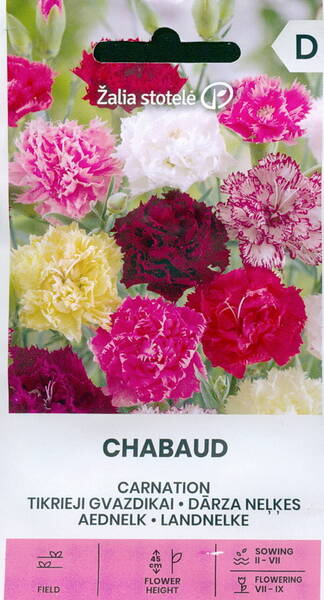Ex Tax: 1.05€
Sophistication in every flower! Great cut!
A perennial herbaceous plant cultivated in our cool climate as an annual. The bushes are compact, up to 50 cm high. The leaves are narrow-linear, bluish-green with a waxy coating.
The flowers on strong peduncles are large, double, 4-6 cm in diameter. To obtain a larger flower, it is necessary to remove the side shoots and buds, leaving one central one.
The plant is light-loving and quite cold-resistant.
They are grown mainly for cutting, flower decoration of flower beds, borders, and mixborders.

Agrotechnics.
Sowing: January - February for seedlings at a temperature of +12+15°C. It is recommended to plant seedlings twice: in the phase of two cotyledons into boxes and in April in the phase of 2-3 pairs of true leaves into pots or peat-humus pots. After picking, the temperature is maintained at +18+20°C. In the phase of five pairs of leaves, seedlings are pinched to enhance branching. In May, seedlings are planted in open ground with a clod of earth at a distance of 25-40 cm.
Care: to prevent shoots from dying, it is necessary to provide supports. During the budding phase and at the beginning of flowering, fertilizing with complex mineral fertilizers is necessary. To obtain especially large flowers, it is necessary to remove the side shoots and buds, leaving one central one. Prefers light, fertile, loamy soils containing lime.
Flowering: July - October (5.5-6 months after sowing).
The aroma of cloves is deep and enveloping, which is possessed by this special population of cloves with the strongest classic aroma and abundant flowering: timeless, traditional aromas will charge you with vigor, optimism and confidence in the future!
* If you have never tried to “preserve” the scent of blooming roses, then while the bush is flowering (the stronger the scent of the plant variety, the better), pick fresh petals and salt them.
To do this, they must be placed in a glass hermetically sealed container. The petals should be sprinkled thickly with salt, compacted well, and then close the jar. After just a few days, it will be enough to lift the lid and the room will be filled with the smell of roses.
The “conservated” aroma lasts for a long time in a sealed container in a cool, dark place. If you collect rose petals at the time of their bloom, your home will be filled with aroma on special holidays and when guests arrive.















